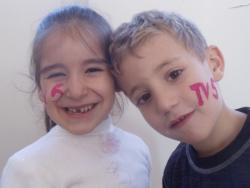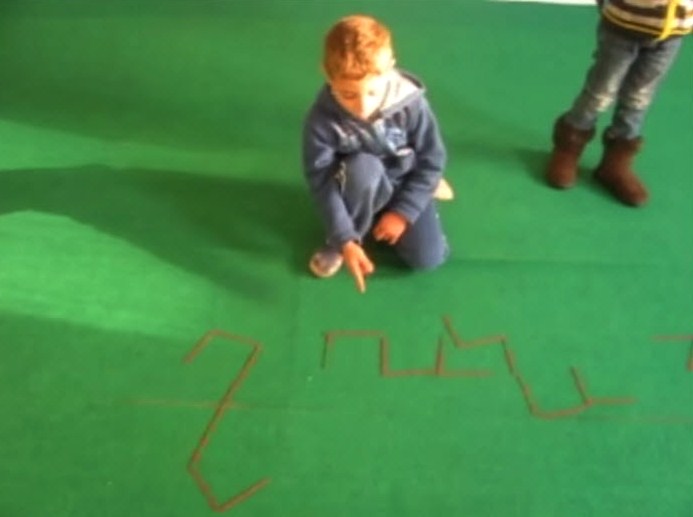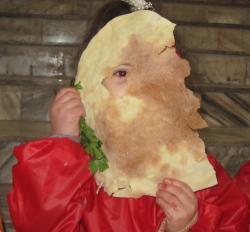Translator: Yura Ganjalyan
Armenian voice, Armenian sound, Armenian letters…,
I wonder who made them up.
There was a time when the one who knew letters was considered to be literate; moreover, he was respected and looked up to. When was it?
It seems a lot of things have changed. You may go to any school in Yerevan and enter a sixth graders’ classroom, and you will see that many things have remained the same.
Five-six-year-old children go to school. All the grown-ups have thoroughly prepared them. You may ask any five-six-year-old child why he/she goes to school. The answer will be, “To learn the letters and be an excellent pupil.” They also know some more things: to sit silently, listen to the teacher, not to run about, not to make a noise, not to speak during the lesson, not even to go to the toilet…
Poor six-year-old child! Imagine the situation he/she is in: it is stricter than in prison. And what will be if the teacher happens to be strict? That will be the end: many parents’ dream will come true. For a whole year they are busy teaching the alphabet, as if they don’t have anything else to do; the aim of the teacher, parent and headmaster is teaching their pupils and offsprings thօse 39 letters. Actually the letters remain lifeless signs for the learners. Moreover, they may hit on the child’s head for forgetting a letter, or the other hits on the child’s hand for writing the letters in a crooked way. After all these will the five-six-year-old child’s attitude be towards the letters he/she writes? The letters are strange to him: they are merely signs.
Let’s leave aside gorgeous words and look at reality. Like many other things we teach the alphabet to the children in a way that causes their unwillingness. Is it a challenging thing to remember 39 signs by constantly using them? It may simply be done all in the natural order of things. Speech, word, syllable, sound, phoneme… Even if we divite speech in semantic groups, the semantic groups – into words and then up to separate sounds, what will it give to the pupil? How will a 5-year-old pupil assimilate and feel it?… especially feel i?
Language perception
Alphabet teaching is artificially divided into separate parts-periods with their objectives: pre-alphabet, alphabet and post-alphabet. With this division alphabet teaching has become a goal, hasn’t it? It is so beginning with the word combination “Alphabet teaching“.
At the age of 5 nearly everything is assimilated at the level of perception. And language perception is the garanty of language acquisition, imaginative thinking and appropriate usage of words and formation of fluent and literate speech. This perception has been forming and developing since birthday by hearing speech, forming speech and assimilating speech. It means that the child gets to know and assimilates all the language elements (speech, words and sounds) by playing. How can we separate the letters from all these? What will you say when they are needed? Will you tell the child to wait? Do we do so at home? Why do we create-make up artificial stages at school?
The learner plays with voice during school activities: the morning ritual “Voice Game“, the project “Music out of Noise”, the project “Clatters”, the listening project “Voices” that of animals, nature, space, human emotions, manmade. They play with voices as a ritual ceremony. Wind has come into our classroom today. What sounds does wind make when it blows quietly? How does it change its voice when it blows stronger? And what happens when it is storming?
In the morning they play with sounds and voices with “a” or “s” from low to high, from high to low. They keep their voice at a certain height, and then low it to the level of whisper, and then they pronounce it silently to themselves. This morning game is an opportunity to pronounce sounds and listen to them and correct them in case of mispronunciation.
Every day they are given sheets of paper on which they see their image and names. They put a tick in front of their names thus asserting their presence at the lesson. If this is done consistently the learners recognize the letters of their names very soon. There can be a learner who will be able to read, another one may read a bit later. Everybody will be ready to begin reading, because they will have the necessary pre-reading skills.

They play with letters. The morning word game has the following components: explaining the meaning of simple words, explaining the meanings of compound words, combining of words, making up new words. They draw something, for example a tree, and then they draw the letter T next to the picture of the tree. And then another picture is drawn with the initial letter of its name. So these are letter-images. They can have thematic letter images, for example the “New Year” theme will be full of the first letters of the images connected with the New Year: Santa, kindness, snowman… There may be word combinations and expressions. If the children wanted to write and idea or a wish it would be wonderful. They can open a new file and every day fill it in with new words until the New Year comes….
5-year-old children’s TV5 and Radio-5 are means of constructing speech and even using various styles.
It’s wonderful that we have the electronic magazaine “Partez” which has such sections as: Media Reader, Audio Library, Game Zone. The learners play with literary creations. It is difficult for the children to retell but easy to watch these pieces of literature. The original electronic versions of these creations can also be found in our media library: Hovhannes Tumanyan, Ghazaros Aghayan, Atabek Khnkoyan, Komitas and Gianni Rodari and also folklore. The learners tell about their activities. They also take interviews. So the learners make their speech lively. In this way the learners’ speech is gradually formed. It is formed by using and promoting their thinking abilities and imagination…. Alphabet learning is a spontaneous and practical process. Many children already know the alphabet before coming to school. The see and «read» street notices with the help of adults. So the easiest way of learning the alphabet for children is through meeting their interests and requirements.
Creating a merry alphabet book

They bake lavash to treat their friends and guests and then they want to write lavash… Why shouldn’t they? Let them type and draw this word. The pages will be collected, and little by little a merry Alphabet book will be created. Who said that there should be only one alphabet book? There can be various alphabet books. If we add music to this alphabet book, we will have a playlist alphabet book. Man usually learns something if he needs it, and he learns it by practicing.
They use a rope to hang the paper pages with newly created images of letters, words, different things. What a merry alphabet it is! We can also see the names of their friends, close relations and parents, and especially Mother’s name. Let them write, no matter they have learned a definite letter or not.
Here is merry arithmetics. He we can find speech, arithmetics, creaive approach, thinking by playing. How can we compare the wonderful really amusing and musical alphabet books created by children with the only alphabet book created by adults. Is there any connection between the author and children and the alphabet they need? It is sad and lifeless. It doesn’t have any connection with children’s imagination and creativity. There is no colour, no game, no feeling.

